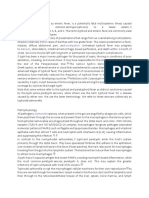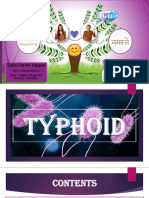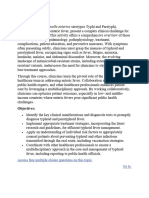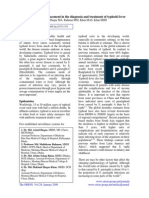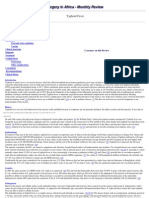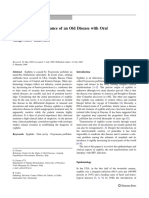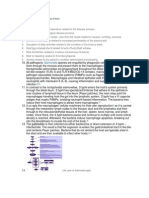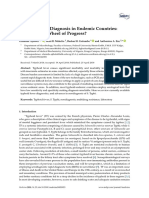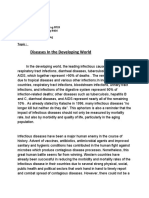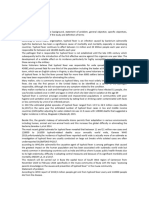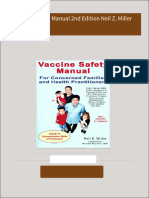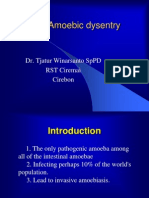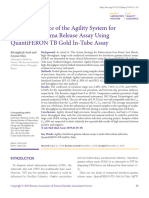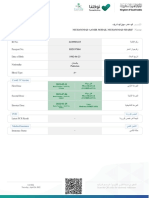Typhoid Fever
Typhoid Fever
Uploaded by
Fajar NarakusumaCopyright:
Available Formats
Typhoid Fever
Typhoid Fever
Uploaded by
Fajar NarakusumaCopyright
Available Formats
Share this document
Did you find this document useful?
Is this content inappropriate?
Copyright:
Available Formats
Typhoid Fever
Typhoid Fever
Uploaded by
Fajar NarakusumaCopyright:
Available Formats
8/29/13
Typhoid Fever
Today News Reference Education Log In Register
Typhoid Fever
Author: John L Brusch, MD, FACP; Chief Editor: Burke A Cunha, MD more... Updated: Sep 12, 2012
Background
Typhoid fever, also known as enteric fever, is a potentially fatal multisystemic illness caused primarily by Salmonella typhi. The protean manifestations of typhoid fever make this disease a true diagnostic challenge. The classic presentation includes fever, malaise, diffuse abdominal pain, and constipation. Untreated, typhoid fever is a grueling illness that may progress to delirium, obtundation, intestinal hemorrhage, bowel perforation, and death within one month of onset. Survivors may be left with long-term or permanent neuropsychiatric complications. S typhi has been a major human pathogen for thousands of years, thriving in conditions of poor sanitation, crowding, and social chaos. It may have responsible for the Great Plague of Athens at the end of the Pelopennesian War.[1] The name S typhi is derived from the ancient Greek typhos, an ethereal smoke or cloud that was believed to cause disease and madness. In the advanced stages of typhoid fever, the patient's level of consciousness is truly clouded. Although antibiotics have markedly reduced the frequency of typhoid fever in the developed world, it remains endemic in developing countries.[2]
Transmission
S typhi has no nonhuman vectors. The following are modes of transmission: Oral transmission via food or beverages handled by an individual who chronically sheds the bacteria through stool or, less commonly, urine Hand-to-mouth transmission after using a contaminated toilet and neglecting hand hygiene Oral transmission via sewage-contaminated water or shellfish (especially in the developing world)[3] An inoculum as small as 100,000 organisms causes infection in more than 50% of healthy volunteers.[4]
Pathophysiology
All pathogenic Salmonella species are engulfed by phagocytic cells, which then pass them through the mucosa and present them to the macrophages in the lamina propria. Nontyphoidal salmonellae are phagocytized throughout the distal ileum and colon. With toll-like receptor (TLR)5 and TLR-4/MD2/CD-14 complex, macrophages recognize pathogen-associated molecular patterns (PAMPs) such as flagella and lipopolysaccharides. Macrophages and intestinal epithelial cells then attract T cells and neutrophils with interleukin 8 (IL-8), causing inflammation and suppressing the infection.[5, 6] In contrast to the nontyphoidal salmonellae, S typhi enters the host's system primarily through the distal ileum. S typhi has specialized fimbriae that adhere to the epithelium over clusters of lymphoid tissue in the ileum (Peyer patches), the main relay point for macrophages traveling from the gut into the lymphatic system. S typhi has a Vi capsular antigen that masks PAMPs, avoiding neutrophil-based inflammation. The bacteria then induce their host macrophages to attract more macrophages.[5] S typhi co-opts the macrophages' cellular machinery for its own reproduction[7] as it is carried through the mesenteric lymph nodes to the thoracic duct and the lymphatics and then through to the reticuloendothelial tissues of the liver, spleen, bone marrow, and lymph nodes. Once there, the S typhi bacteria pause and continue to multiply until some critical density is reached. Afterward, the bacteria induce macrophage apoptosis, breaking out into the bloodstream to invade the rest of the body.[6] The bacteria then infect the gallbladder via either bacteremia or direct extension of S typhi infected bile. The result is that the organism re-enters the gastrointestinal tract in the bile and reinfects Peyer patches. Bacteria that do
emedicine.medscape.com/article/231135-overview 1/13
8/29/13
Typhoid Fever
not reinfect the host are typically shed in the stool and are then available to infect other hosts.[6, 2]
Life cycle of Salmonella typhi.
Risk factors
S typhi are able to survive a stomach pH as low as 1.5. Antacids, histamine-2 receptor antagonists (H2 blockers), proton pump inhibitors, gastrectomy, and achlorhydria decrease stomach acidity and facilitate S typhi infection.[6] HIV/AIDS is clearly associated with an increased risk of nontyphoidal Salmonella infection; however, the data and opinions in the literature as to whether this is true for S typhi infection are conflicting. If an association exists, it is probably minor.[8, 9, 10, 11] Other risk factors for clinical S typhi infection include various genetic polymorphisms. These risk factors often also predispose to other intracellular pathogens. For instance, PARK2 and PACGR code for a protein aggregate that is essential for breaking down the bacterial signaling molecules that dampen the macrophage response. Polymorphisms in their shared regulatory region are found disproportionately in persons infected with Mycobacterium leprae and S typhi.[12] On the other hand, protective host mutations also exist. The fimbriae of S typhi bind in vitro to cystic fibrosis transmembrane conductance receptor (CFTR), which is expressed on the gut membrane. Two to 5% of white persons are heterozygous for the CFTR mutation F508del, which is associated with a decreased susceptibility to typhoid fever, as well as to cholera and tuberculosis. The homozygous F508del mutation in CFTR is associated with cystic fibrosis. Thus, typhoid fever may contribute to evolutionary pressure that maintains a steady occurrence of cystic fibrosis, just as malaria maintains sickle cell disease in Africa.[13, 14] Environmental and behavioral risk factors that are independently associated with typhoid fever include eating food from street vendors, living in the same household with someone who has new case of typhoid fever, washing the hands inadequately, sharing food from the same plate, drinking unpurified water, and living in a household that does not have a toilet.[15, 12] As the middle class in south Asia grows, some hospitals there are seeing a large number of typhoid fever cases among relatively well-off university students who live in group households with poor hygeine.[16] American clinicians should keep this in mind, as members of this cohort often come to the United States for higher degrees.
Epidemiology
Frequency
United States Since 1900, improved sanitation and successful antibiotic treatment have steadily decreased the incidence of typhoid fever in the United States. In 1920, 35,994 cases of typhoid fever were reported. In 2006, there were 314. Between 1999 and 2006, 79% of typhoid fever cases occurred in patients who had been outside of the country within the preceding 30 days. Two thirds of these individuals had just journeyed from the Indian subcontinent. The 3 known outbreaks of typhoid fever within the United States were traced to imported food or to a food handler from an endemic region. Remarkably, only 17% of cases acquired domestically were traced to a carrier.[17] International Typhoid fever occurs worldwide, primarily in developing nations whose sanitary conditions are poor. Typhoid fever is endemic in Asia, Africa, Latin America, the Caribbean, and Oceania, but 80% of cases come from Bangladesh, China, India, Indonesia, Laos, Nepal, Pakistan, or Vietnam.[18] Within those countries, typhoid fever is most common in underdeveloped areas. Typhoid fever infects roughly 21.6 million people (incidence of 3.6 per 1,000
emedicine.medscape.com/article/231135-overview 2/13
8/29/13
Typhoid Fever
population) and kills an estimated 200,000 people every year.[19] In the United States, most cases of typhoid fever arise in international travelers. The average yearly incidence of typhoid fever per million travelers from 1999-2006 by county or region of departure was as follows:[17] Canada - 0 Western Hemisphere outside Canada/United States - 1.3 Africa - 7.6 Asia - 10.5 India - 89 (122 in 2006) Total (for all countries except Canada/United States) - 2.2
Mortality/Morbidity
With prompt and appropriate antibiotic therapy, typhoid fever is typically a short-term febrile illness requiring a median of 6 days of hospitalization. Treated, it has few long-term sequelae and a 0.2% risk of mortality.[17] Untreated typhoid fever is a life-threatening illness of several weeks' duration with long-term morbidity often involving the central nervous system. The case fatality rate in the United States in the pre-antibiotic era was 9%-13%.[20]
Race
Typhoid fever has no racial predilection.
Sex
Fifty-four percent of typhoid fever cases in the United States reported between 1999 and 2006 involved males.[17]
Age
Most documented typhoid fever cases involve school-aged children and young adults. However, the true incidence among very young children and infants is thought to be higher. The presentations in these age groups may be atypical, ranging from a mild febrile illness to severe convulsions, and the S typhi infection may go unrecognized. This may account for conflicting reports in the literature that this group has either a very high or a very low rate of morbidity and mortality.[16, 21]
Contributor Information and Disclosures
Author John L Brusch, MD, FACP Assistant Professor of Medicine, Harvard Medical School; Consulting Staff, Department of Medicine and Infectious Disease Service, Cambridge Health Alliance John L Brusch, MD, FACP is a member of the following medical societies: American College of Physicians and Infectious Diseases Society of America Disclosure: Nothing to disclose. Coauthor(s) Thomas Garvey, MD, JD Primary Care Physician, Burlington Medical Associates; Co-chair, Medical Advisory Committee for the Elimination of Tuberculosis Thomas Garvey, MD, JD is a member of the following medical societies: American College of Legal Medicine, American College of Physicians, and American Society of Law, Medicine & Ethics Disclosure: Nothing to disclose. Roberto Corales, DO Vice President, Chief Medical Officer and Principal Investigator, AIDS Care Roberto Corales, DO is a member of the following medical societies: American Medical Association, American Osteopathic Association, and International AIDS Society Disclosure: Nothing to disclose. Steven K Schmitt MD, Staff Physician, Department of Infectious Disease, Cleveland Clinic Steven K Schmitt is a member of the following medical societies: Infectious Diseases Society of America
emedicine.medscape.com/article/231135-overview
3/13
8/29/13
Typhoid Fever
Disclosure: Nothing to disclose. Specialty Editor Board Martin J Wood, MD Former Consulting Staff, Department of Infection and Tropical Medicine, Birmingham Heartlands Hospital, UK Martin J Wood, MD is a member of the following medical societies: Alliance for the Prudent Use of Antibiotics, American Society for Microbiology, Infectious Diseases Society of America, International Society for Infectious Diseases, and Royal College of Physicians Disclosure: Nothing to disclose. Francisco Talavera, PharmD, PhD Adjunct Assistant Professor, University of Nebraska Medical Center College of Pharmacy; Editor-in-Chief, Medscape Drug Reference Disclosure: Medscape Salary Employment Richard B Brown, MD, FACP Chief, Division of Infectious Diseases, Baystate Medical Center; Professor, Department of Internal Medicine, Tufts University School of Medicine Richard B Brown, MD, FACP is a member of the following medical societies: Alpha Omega Alpha, American College of Chest Physicians, American College of Physicians, American Medical Association, American Society for Microbiology, Infectious Diseases Society of America, and Massachusetts Medical Society Disclosure: Nothing to disclose. Chief Editor Burke A Cunha, MD Professor of Medicine, State University of New York School of Medicine at Stony Brook; Chief, Infectious Disease Division, Winthrop-University Hospital Burke A Cunha, MD is a member of the following medical societies: American College of Chest Physicians, American College of Physicians, and Infectious Diseases Society of America Disclosure: Nothing to disclose.
References
1. Papagrigorakis MJ, Synodinos PN, Yapijakis C. Ancient typhoid epidemic reveals possible ancestral strain of Salmonella enterica serovar Typhi. Infect Genet Evol. Jan 2007;7(1):126-7. [Medline]. [Full Text]. 2. Christie AB. Infectious Diseases: Epidemiology and Clinical Practice. 4th ed. Edinburgh, Scotland: Churchill Livingstone; 1987. 3. Earampamoorthy S, Koff RS. Health hazards of bivalve-mollusk ingestion. Ann Intern Med. Jul 1975;83(1):107-10. [Medline]. [Full Text]. 4. Levine MM, Tacket CO, Sztein MB. Host-Salmonella interaction: human trials. Microbes Infect. Nov-Dec 2001;3(14-15):1271-9. [Medline]. 5. Raffatellu M, Chessa D, Wilson RP, Tkel C, Akelik M, Bumler AJ. Capsule-mediated immune evasion: a new hypothesis explaining aspects of typhoid fever pathogenesis. Infect Immun. Jan 2006;74(1):19-27. [Medline]. 6. Parry CM, Hien TT, Dougan G, et al. Typhoid fever. N Engl J Med. Nov 28 2002;347(22):1770-82. [Medline]. [Full Text]. 7. Ramsden AE, Mota LJ, Mnter S, Shorte SL, Holden DW. The SPI-2 type III secretion system restricts motility of Salmonella-containing vacuoles. Cell Microbiol. Oct 2007;9(10):2517-29. [Medline]. 8. Gotuzzo E, Frisancho O, Sanchez J, Liendo G, Carrillo C, Black RE, et al. Association between the acquired immunodeficiency syndrome and infection with Salmonella typhi or Salmonella paratyphi in an endemic typhoid area. Arch Intern Med. Feb 1991;151(2):381-2. [Medline]. 9. Manfredi R, Chiodo F. Salmonella typhi disease in HIV-infected patients: case reports and literature review. Infez Med. 1999;7(1):49-53. [Medline]. 10. Gordon MA, Graham SM, Walsh AL, Wilson L, Phiri A, Molyneux E, et al. Epidemics of invasive Salmonella enterica serovar enteritidis and S. enterica Serovar typhimurium infection associated with multidrug resistance among adults and children in Malawi. Clin Infect Dis . Apr 1 2008;46(7):963-9.
emedicine.medscape.com/article/231135-overview 4/13
8/29/13
Typhoid Fever
[Medline]. 11. Monack DM, Mueller A, Falkow S. Persistent bacterial infections: the interface of the pathogen and the host immune system. Nat Rev Microbiol. Sep 2004;2(9):747-65. [Medline]. 12. Ali S, Vollaard AM, Widjaja S, Surjadi C, van de Vosse E, van Dissel JT. PARK2/PACRG polymorphisms and susceptibility to typhoid and paratyphoid fever. Clin Exp Immunol. Jun 2006;144(3):425-31. [Medline]. 13. van de Vosse E, Ali S, de Visser AW, Surjadi C, Widjaja S, Vollaard AM, et al. Susceptibility to typhoid fever is associated with a polymorphism in the cystic fibrosis transmembrane conductance regulator (CFTR). Hum Genet. Oct 2005;118(1):138-40. [Medline]. 14. Poolman EM, Galvani AP. Evaluating candidate agents of selective pressure for cystic fibrosis. J R Soc Interface. Feb 22 2007;4(12):91-8. [Medline]. 15. Ram PK, Naheed A, Brooks WA, Hossain MA, Mintz ED, Breiman RF. Risk factors for typhoid fever in a slum in Dhaka, Bangladesh. Epidemiol Infect. Apr 2007;135(3):458-65. [Medline]. 16. Dutta TK, Beeresha, Ghotekar LH. Atypical manifestations of typhoid fever. J Postgrad Med. Oct-Dec 2001;47(4):248-51. [Medline]. 17. Lynch MF, Blanton EM, Bulens S, Polyak C, Vojdani J, Stevenson J. Typhoid fever in the United States, 1999-2006. JAMA. Aug 26 2009;302(8):859-65. [Medline]. 18. Chau TT, Campbell JI, Galindo CM, Van Minh Hoang N, Diep TS, Nga TT, et al. Antimicrobial drug resistance of Salmonella enterica serovar typhi in asia and molecular mechanism of reduced susceptibility to the fluoroquinolones. Antimicrob Agents Chemother. Dec 2007;51(12):4315-23. [Medline]. 19. Crump JA, Luby SP, Mintz ED. The global burden of typhoid fever. Bull World Health Organ. May 2004;82(5):346-53. [Medline]. 20. Crump JA, Ram PK, Gupta SK, Miller MA, Mintz ED. Part I. Analysis of data gaps pertaining to Salmonella enterica serotype Typhi infections in low and medium human development index countries, 1984-2005. Epidemiol Infect. Apr 2008;136(4):436-48. [Medline]. 21. Mulligan TO. Typhoid fever in young children. Br Med J . Dec 11 1971;4(5788):665-7. [Medline]. 22. Rahaman MM, Jamiul AK. Rose spots in shigellosis caused by Shigella dysenteriae type 1 infection. Br Med J . Oct 29 1977;2(6095):1123-4. [Medline]. 23. Cunha BA. Malaria or typhoid fever: a diagnostic dilemma?. Am J Med. Dec 2005;118(12):1442-3; author reply 1443-4. [Medline]. 24. Woodward TE, Smadel JE. Management of typhoid fever and its complications. Ann Intern Med. Jan 1964;60:144-57. [Medline]. 25. Hermans P, Gerard M, van Laethem Y, et al. Pancreatic disturbances and typhoid fever. Scand J Infect Dis . 1991;23(2):201-5. [Medline]. 26. Butler T, Islam A, Kabir I, et al. Patterns of morbidity and mortality in typhoid fever dependent on age and gender: review of 552 hospitalized patients with diarrhea. Rev Infect Dis . Jan-Feb 1991;13(1):85-90. [Medline]. 27. Butler T, Knight J, Nath SK, et al. Typhoid fever complicated by intestinal perforation: a persisting fatal disease requiring surgical management. Rev Infect Dis . Mar-Apr 1985;7(2):244-56. [Medline]. 28. Crum NF. Current trends in typhoid Fever. Curr Gastroenterol Rep. Aug 2003;5(4):279-86. [Medline]. 29. Huang DB, DuPont HL. Problem pathogens: extra-intestinal complications of Salmonella enterica serotype Typhi infection. Lancet Infect Dis . Jun 2005;5(6):341-8. [Medline]. 30. Abdel Wahab MF, el-Gindy IM, Sultan Y, el-Naby HM. Comparative study on different recent diagnostic and therapeutic regimens in acute typhoid fever. J Egypt Public Health Assoc . 1999;74(1-2):193-205. [Medline]. 31. Wain J, Pham VB, Ha V, Nguyen NM, To SD, Walsh AL, et al. Quantitation of bacteria in bone marrow from patients with typhoid fever: relationship between counts and clinical features. J Clin Microbiol. Apr 2001;39(4):1571-6. [Medline]. 32. Escamilla J, Florez-Ugarte H, Kilpatrick ME. Evaluation of blood clot cultures for isolation of Salmonella typhi, Salmonella paratyphi-A, and Brucella melitensis. J Clin Microbiol. Sep 1986;24(3):388-90.
emedicine.medscape.com/article/231135-overview 5/13
8/29/13
Typhoid Fever
[Medline]. 33. Gilman RH, Terminel M, Levine MM, Hernandez-Mendoza P, Hornick RB. Relative efficacy of blood, urine, rectal swab, bone-marrow, and rose-spot cultures for recovery of Salmonella typhi in typhoid fever. Lancet. May 31 1975;1(7918):1211-3. [Medline]. 34. Farooqui BJ, Khurshid M, Ashfaq MK, Khan MA. Comparative yield of Salmonella typhi from blood and bone marrow cultures in patients with fever of unknown origin. J Clin Pathol. Mar 1991;44(3):258-9. [Medline]. 35. Ambati SR, Nath G, Das BK. Diagnosis of typhoid fever by polymerase chain reaction. Indian J Pediatr. Oct 2007;74(10):909-13. [Medline]. 36. Song JH, Cho H, Park MY, et al. Detection of Salmonella typhi in the blood of patients with typhoid fever by polymerase chain reaction. J Clin Microbiol. Jun 1993;31(6):1439-43. [Medline]. 37. Sadallah F, Brighouse G, Del Giudice G, et al. Production of specific monoclonal antibodies to Salmonella typhi flagellin and possible application to immunodiagnosis of typhoid fever. J Infect Dis . Jan 1990;161(1):59-64. [Medline]. 38. Balasubramanian S, Kaarthigeyan K, Srinivas S, Rajeswari R. Serum ALT: LDH Ratio in Typhoid Fever and Acute Viral Hepatitis. Indian Pediatr. Jul 1 2009;[Medline]. 39. Capoor MR, Nair D, Deb M, Aggarwal P. Enteric fever perspective in India: emergence of high-level ciprofloxacin resistance and rising MIC to cephalosporins. J Med Microbiol. Aug 2007;56:1131-2. [Medline]. 40. Pai H, Byeon JH, Yu S, Lee BK, Kim S. Salmonella enterica serovar typhi strains isolated in Korea containing a multidrug resistance class 1 integron. Antimicrob Agents Chemother. Jun 2003;47(6):2006-8. [Medline]. 41. Mamun KZ, Tabassum S, Ashna SM, Hart CA. Molecular analysis of multi-drug resistant Salmonella typhi from urban paediatric population of Bangladesh. Bangladesh Med Res Counc Bull. Dec 2004;30(3):81-6. [Medline]. 42. Ahmed D, D'Costa LT, Alam K, Nair GB, Hossain MA. Multidrug-resistant Salmonella enterica serovar typhi isolates with high-level resistance to ciprofloxacin in Dhaka, Bangladesh. Antimicrob Agents Chemother. Oct 2006;50(10):3516-7. [Medline]. 43. Zhanel GG, Smith HJ. Flouroquinolone resistance-associated gene mutations in Streptococcus pneumoniae. In: Fuchs J, Podda M, eds. Encyclopedia of Medical Genomics and Proteomics . CRC Press; 2004:497-8. [Full Text]. 44. Turner AK, Nair S, Wain J. The acquisition of full fluoroquinolone resistance in Salmonella Typhi by accumulation of point mutations in the topoisomerase targets. J Antimicrob Chemother. Oct 2006;58(4):733-40. [Medline]. 45. Effa EE, Lassi ZS, Critchley JA, et al. Fluoroquinolones for treating typhoid and paratyphoid fever (enteric fever). Cochrane Database Syst Rev. Oct 5 2011;CD004530. [Medline]. 46. Arjyal A, Pandit A. Treatment of enteric fever. J Infect Dev Ctries . Dec 1 2008;2(6):426-30. [Medline]. 47. Kundu R, Ganguly N, Ghosh TK, et al. IAP Task Force Report: management of enteric fever in children. Indian Pediatr. Oct 2006;43(10):884-7. [Medline]. 48. Islam MN, Rahman ME, Rouf MA, Islam MN, Khaleque MA, Siddika M, et al. Efficacy of azithromycin in the treatment of childhood typhoid Fever. Mymensingh Med J . Jul 2007;16(2):149-53. [Medline]. 49. Acosta C et al. Back ground document: The diagnosis, treatment and prevention of typhoid fever. Geneva, Switzerland: World Health Organization; 07/2003. Vaccines and Biologicals. [Full Text]. 50. Dutta S, Sur D, Manna B, Bhattacharya SK, Deen JL, Clemens JD. Rollback of Salmonella enterica serotype Typhi resistance to chloramphenicol and other antimicrobials in Kolkata, India. Antimicrob Agents Chemother. Apr 2005;49(4):1662-3. [Medline]. 51. Vaccines and Biologicals . Geneva, Switzerland: World Health Organization; May, 2003. 52. Cooke FJ, Wain J. The emergence of antibiotic resistance in typhoid fever. Travel Med Infect Dis . May 2004;2(2):67-74. [Medline]. 53. Trivedi NA, Shah PC. A meta-analysis comparing the safety and efficacy of azithromycin over the alternate drugs used for treatment of uncomplicated enteric fever. J Postgrad Med. Apr 2012;58(2):112-8.
emedicine.medscape.com/article/231135-overview 6/13
8/29/13
Typhoid Fever
[Medline]. 54. Hoffman SL, Punjabi NH, Kumala S, et al. Reduction of mortality in chloramphenicol-treated severe typhoid fever by high-dose dexamethasone. N Engl J Med. Jan 12 1984;310(2):82-8. [Medline]. 55. Bhutta ZA. Current concepts in the diagnosis and treatment of typhoid fever. BMJ . Jul 8 2006;333(7558):78-82. [Medline]. 56. Rogerson SJ, Spooner VJ, Smith TA, et al. Hydrocortisone in chloramphenicol-treated severe typhoid fever in Papua New Guinea. Trans R Soc Trop Med Hyg. Jan-Feb 1991;85(1):113-6. [Medline]. 57. Acharya IL, Lowe CU, Thapa R, et al. Prevention of typhoid fever in Nepal with the Vi capsular polysaccharide of Salmonella typhi. A preliminary report. N Engl J Med. Oct 29 1987;317(18):1101-4. [Medline]. 58. [Best Evidence] Sur D, Ochiai RL, Bhattacharya SK, Ganguly NK, Ali M, Manna B, et al. A clusterrandomized effectiveness trial of Vi typhoid vaccine in India. N Engl J Med. Jul 23 2009;361(4):335-44. [Medline]. 59. Hanel RA, Araujo JC, Antoniuk A, et al. Multiple brain abscesses caused by Salmonella typhi: case report. Surg Neurol. Jan 2000;53(1):86-90. [Medline]. 60. Koul PA, Wani JI, Wahid A, et al. Pulmonary manifestations of multidrug-resistant typhoid fever. Chest. Jul 1993;104(1):324-5. [Medline]. 61. Khan M, Coovadia Y, Sturm AW. Typhoid fever complicated by acute renal failure and hepatitis: case reports and review. Am J Gastroenterol. Jun 1998;93(6):1001-3. [Medline]. 62. Sitprija V, Pipantanagul V, Boonpucknavig V, et al. Glomerulitis in typhoid fever. Ann Intern Med. Aug 1974;81(2):210-3. [Medline]. 63. Baker NM, Mills AE, Rachman I, et al. Haemolytic-uraemic syndrome in typhoid fever. Br Med J . Apr 13 1974;2(5910):84-7. [Medline]. 64. Naidoo PM, Yan CC. Typhoid polymyositis. S Afr Med J . Nov 8 1975;49(47):1975-6. [Medline]. 65. Breakey WR, Kala AK. Typhoid catatonia responsive to ECT. Br Med J . Aug 6 1977;2(6083):357-9. [Medline]. 66. Ackers ML, Puhr ND, Tauxe RV, et al. Laboratory-based surveillance of Salmonella serotype Typhi infections in the United States: antimicrobial resistance on the rise. JAMA. May 24-31 2000;283(20):2668-73. [Medline]. [Full Text]. 67. Adam D. Use of quinolones in pediatric patients. Rev Infect Dis . Jul-Aug 1989;11 Suppl 5:S1113-6. [Medline]. 68. Akalin HE. Quinolones in the treatment of typhoid fever. Drugs . 1999;58 Suppl 2:52-4. [Medline]. 69. Ambrosch F, Fritzell B, Gregor J, et al. Combined vaccination against yellow fever and typhoid fever: a comparative trial. Vaccine. May 1994;12(7):625-8. [Medline]. 70. Anand AC, Kataria VK, Singh W, et al. Epidemic multiresistant enteric fever in eastern India. Lancet. Feb 10 1990;335(8685):352. [Medline]. 71. Angorn IB, Pillay SP, Hegarty M, et al. Typhoid perforation of the ileum: A therapeutic dilemma. S Afr Med J . May 3 1975;49(19):781-4. [Medline]. 72. Cunha BA. Antibiotic Essentials . 7th Ed. Royal Oak, MI: Physicians Press; 2008. 73. Archampong EQ. Operative treatment of typhoid perforation of the bowel. Br Med J . Aug 2 1969;3(5665):273-6. [Medline]. 74. Ashcroft MT, Singh B, Nicholson CC, et al. A seven-year field trial of two typhoid vaccines in Guyana. Lancet. Nov 18 1967;2(7525):1056-9. [Medline]. 75. Bitar R, Tarpley J. Intestinal perforation in typhoid fever: a historical and state-of-the-art review. Rev Infect Dis . Mar-Apr 1985;7(2):257-71. [Medline]. 76. Blaser MJ, Hickman FW, Farmer JJ 3rd, et al. Salmonella typhi: the laboratory as a reservoir of infection. J Infect Dis . Dec 1980;142(6):934-8. [Medline]. 77. Blaser MJ, Newman LS. A review of human salmonellosis: I. Infective dose. Rev Infect Dis . Nov-Dec
emedicine.medscape.com/article/231135-overview 7/13
8/29/13
Typhoid Fever
1982;4(6):1096-106. [Medline]. 78. Bodhidatta L, Taylor DN, Thisyakorn U, et al. Control of typhoid fever in Bangkok, Thailand, by annual immunization of schoolchildren with parenteral typhoid vaccine. Rev Infect Dis . Jul-Aug 1987;9(4):841-5. [Medline]. 79. Brumell JH, Grinstein S. Salmonella redirects phagosomal maturation. Curr Opin Microbiol. Feb 2004;7(1):78-84. [Medline]. [Full Text]. 80. Butler T, Rumans L, Arnold K. Response of typhoid fever caused by chloramphenicol-susceptible and chloramphenicol-resistant strains of Salmonella typhi to treatment with trimethoprim-sulfamethoxazole. Rev Infect Dis . Mar-Apr 1982;4(2):551-61. [Medline]. 81. Calva JJ, Ruiz-Palacios GM. Salmonella hepatitis: detection of salmonella antigens in the liver of patients with typhoid fever. J Infect Dis . Aug 1986;154(2):373-4. [Medline]. 82. Cancellieri V, Fara GM. Demonstration of specific IgA in human feces after immunization with live Ty21a Salmonella typhi vaccine. J Infect Dis . Mar 1985;151(3):482-4. [Medline]. 83. Capoor MR, Rawat D, Nair D, Hasan AS, Deb M, Aggarwal P, et al. In vitro activity of azithromycin, newer quinolones and cephalosporins in ciprofloxacin-resistant Salmonella causing enteric fever. J Med Microbiol. Nov 2007;56:1490-4. [Medline]. 84. Carcelen A, Chirinos J, Yi A. Furazolidone and chloramphenicol for treatment of typhoid fever. Scand J Gastroenterol Suppl. 1989;169:19-23. [Medline]. 85. Centers for Disease Control and Prevention. CDC Typhoid Immunization Recommendations of the Advisory Committee on Immunization Practices (ACIP). MMWR. 1994;43(RR-14):1-7. 86. Coovadia YM, Gathiram V, Bhamjee A, et al. An outbreak of multiresistant Salmonella typhi in South Africa. Q J Med. Feb 1992;82(298):91-100. [Medline]. 87. Crosa JH, Brenner DJ, Ewing WH, et al. Molecular relationships among the Salmonelleae. J Bacteriol. Jul 1973;115(1):307-15. [Medline]. 88. Cryz SJ Jr. Post-marketing experience with live oral Ty21a vaccine. Lancet. Jan 2 1993;341(8836):49-50. [Medline]. 89. Cumberland NS, St Clair Roberts J, Arnold WS, et al. Typhoid Vi: a less reactogenic vaccine. J Int Med Res . Jun 1992;20(3):247-53. [Medline]. 90. Cunha BA. Osler on typhoid fever: differentiating typhoid from typhus and malaria. Infect Dis Clin North Am. Mar 2004;18(1):111-25. [Medline]. 91. Cunha BA. Typhoid fever: the temporal relations of key clinical diagnostic points. Lancet Infect Dis . Jun 2006;6(6):318-20; author reply 320-1. [Medline]. 92. Dashti AA, Jadaon MM, Habeeb F, West PW, Panigrahi D, Amyes SG. Salmonella enterica Serotype typhi in Kuwait and its reduced susceptibility to ciprofloxacin. J Chemother. Jun 2008;20(3):297-302. [Medline]. 93. Djemgou PC, Gatsing D, Hegazy ME, El-Hamd Mohamed AH, Ngandeu F, Tane P, et al. Turrealabdane, turreanone and an antisalmonellal agent from Turraeanthus africanus. Planta Med. Feb 2010;76(2):165-71. [Medline]. 94. Dong B, Galindo CM, Shin E, Acosta CJ, Page AL, Wang M, et al. Optimizing typhoid fever case definitions by combining serological tests in a large population study in Hechi City, China. Epidemiol Infect. Aug 2007;135(6):1014-20. [Medline]. 95. Duggan MB, Beyer L. Enteric fever in young Yoruba children. Arch Dis Child. Jan 1975;50(1):67-71. [Medline]. 96. Dunne EF, Fey PD, Kludt P, et al. Emergence of domestically acquired ceftriaxone-resistant Salmonella infections associated with AmpC beta-lactamase. JAMA. Dec 27 2000;284(24):3151-6. [Medline]. 97. Edelman R, Levine MM. Summary of an international workshop on typhoid fever. Rev Infect Dis . May-Jun 1986;8(3):329-49. [Medline]. 98. Effa EE, Bukirwa H. Azithromycin for treating uncomplicated typhoid and paratyphoid fever (enteric fever). Cochrane Database Syst Rev. Oct 8 2008;CD006083. [Medline]. 99. Farid Z, Higashi GI, Bassily S, et al. Letter: Immune-complex disease in typhoid and paratyphoid fevers.
emedicine.medscape.com/article/231135-overview 8/13
8/29/13
Typhoid Fever
Ann Intern Med. Sep 1975;83(3):432. [Medline]. 100. Farmer JJ. Enterobacteriaceae: introduction and identification. In: Murray PR, Baron EF, Pfaller MA, eds. Manual of Clinical Microbiology. 6th ed. Washington, DC: American Society for Microbiology; 1995:43849. 101. Ferreccio C, Levine MM, Manterola A, Rodriguez G, Rivara I, Prenzel I, et al. Benign bacteremia caused by Salmonella typhi and paratyphi in children younger than 2 years. J Pediatr. Jun 1984;104(6):899-901. [Medline]. 102. Ferreccio C, Levine MM, Rodriguez H, et al. Comparative efficacy of two, three, or four doses of TY21a live oral typhoid vaccine in enteric-coated capsules: a field trial in an endemic area. J Infect Dis . Apr 1989;159(4):766-9. [Medline]. 103. Ferreccio C, Morris JG, Valdivieso C, et al. Efficacy of ciprofloxacin in the treatment of chronic typhoid carriers. J Infect Dis . Jun 1988;157(6):1235-9. [Medline]. 104. Frenck RW Jr, Nakhla I, Sultan Y, Bassily SB, Girgis YF, David J, et al. Azithromycin versus ceftriaxone for the treatment of uncomplicated typhoid fever in children. Clin Infect Dis . Nov 2000;31(5):1134-8. [Medline]. 105. Frenck RW, Nakhla I, Sultan Y, et al. Azithromycin versus ceftriaxone for the treatment of uncomplicated typhoid fever in children. Clin Infect Dis . 2000;31:134-1138. [Medline]. 106. Ghosh SK. Typhoid fever in present-day Britain. Public Health. Jan 1974;88(2):71-8. [Medline]. 107. Gilman RH, Hornick RB, Woodard WE, et al. Evaluation of a UDP-glucose-4-epimeraseless mutant of Salmonella typhi as a liver oral vaccine. J Infect Dis . Dec 1977;136(6):717-23. [Medline]. 108. Gilman RH, Terminel M, Levine MM, et al. Relative efficacy of blood, urine, rectal swab, bone-marrow, and rose- spot cultures for recovery of Salmonella typhi in typhoid fever. Lancet. May 31 1975;1(7918):1211-3. [Medline]. 109. Gorden J, Small PL. Acid resistance in enteric bacteria. Infect Immun. Jan 1993;61(1):364-7. [Medline]. 110. Gordon MA. Salmonella infections in immunocompromised adults. J Infect. Jun 2008;56(6):413-22. [Medline]. 111. Gotuzzo E, Frisancho O, Sanchez J, Liendo G, Carrillo C, Black RE, et al. Association between the acquired immunodeficiency syndrome and infection with Salmonella typhi or Salmonella paratyphi in an endemic typhoid area. Arch Intern Med. Feb 1991;151(2):381-2. [Medline]. 112. Gotuzzo E, Guerra JG, Benavente L, et al. Use of norfloxacin to treat chronic typhoid carriers. J Infect Dis . Jun 1988;157(6):1221-5. [Medline]. 113. Gray LD. Escherichia, Salmonella, Shigella, and Yersinia. In: Murray PR, Baron EJ, Pfaller MA, eds. Manual of Clinical Microbiology. 6th ed. Washington, DC: American Society for Microbiology; 1995:450-6. 114. Greisman SE, Woodward TE, Hornick RB, Snyder MJ, Carozza FA Jr. Typhoid fever: a study of pathogenesis and physiologic abnormalities. Trans Am Clin Climatol Assoc . 1961;73:146-61. [Medline]. 115. Gulati S, Marwaha RK, Prakash D, et al. Multi-drug-resistant Salmonella typhi--a need for therapeutic reappraisal. Ann Trop Paediatr. 1992;12(2):137-41. [Medline]. 116. Gupta A. Multidrug-resistant typhoid fever in children: epidemiology and therapeutic approach. Pediatr Infect Dis J . Feb 1994;13(2):134-40. [Medline]. 117. Gupta SP, Gupta MS, Bhardwaj S, et al. Current clinical patterns of typhoid fever: a prospective study. J Trop Med Hyg. Dec 1985;88(6):377-81. [Medline]. 118. Hensel M. Salmonella pathogenicity island 2. Mol Microbiol. Jun 2000;36(5):1015-23. [Medline]. 119. Herzog C. Chemotherapy of typhoid fever: a review of literature. Infection. 1976;4(3):166-73. [Medline]. 120. Herzog C. New trends in the chemotherapy of typhoid fever. Acta Trop. Sep 1980;37(3):275-80. [Medline]. 121. Hoffman SL, Edman DC, Punjabi NH, et al. Bone marrow aspirate culture superior to streptokinase clot culture and 8 ml 1:10 blood-to-broth ratio blood culture for diagnosis of typhoid fever. Am J Trop Med Hyg. Jul 1986;35(4):836-9. [Medline]. 122. Hoffman SL, Flanigan TP, Klaucke D, et al. The Widal slide agglutination test, a valuable rapid diagnostic test in typhoid fever patients at the Infectious Diseases Hospital of Jakarta. Am J Epidemiol. May
emedicine.medscape.com/article/231135-overview 9/13
8/29/13
Typhoid Fever
1986;123(5):869-75. [Medline]. 123. Hoffman SL, Punjabi NH, Rockhill RC, et al. Duodenal string-capsule culture compared with bone-marrow, blood, and rectal-swab cultures for diagnosing typhoid and paratyphoid fever. J Infect Dis . Feb 1984;149(2):157-61. [Medline]. 124. Hornick RB, DuPont HL, Levine MM, et al. Efficacy of a live oral typhoid vaccine in human volunteers. Dev Biol Stand. 1976;33:89-92. [Medline]. 125. Hornick RB, Greisman SE, Woodward TE, et al. Typhoid fever: pathogenesis and immunologic control. N Engl J Med. Sep 24 1970;283(13):686-91. [Medline]. 126. Hornick RB, Greisman SE, Woodward TE, et al. Typhoid fever: pathogenesis and immunologic control. 2. N Engl J Med. Oct 1 1970;283(14):739-46. [Medline]. 127. Hornick RB, Griesman S. On the pathogenesis of typhoid fever. Arch Intern Med. Mar 1978;138(3):357-9. [Medline]. 128. Hornick RB, Woodward TE. Appraisal of typhoid vaccine in experimentally infected human subjects. Trans Am Clin Climatol Assoc . 1967;78:70-8. [Medline]. 129. Huckstep RL. Recent advances in the surgery of typhoid fever. Ann R Coll Surg Engl. Apr 1960;26:20730. [Medline]. 130. Huckstep RL. Typhoid Fever and Other Salmonella Infections . Edinburgh, Scotland: Churchill Livingstone; 1962. 131. Joshi N, Rajeshwari K, Dubey AP, Singh T, Kaur R. Clinical spectrum of fever of unknown origin among Indian children. Ann Trop Paediatr. Dec 2008;28(4):261-6. [Medline]. 132. Keitel WA, Bond NL, Zahradnik JM, et al. Clinical and serological responses following primary and booster immunization with Salmonella typhi Vi capsular polysaccharide vaccines. Vaccine. 1994;12(3):195-9. [Medline]. 133. Keusch GT. Antimicrobial therapy for enteric infections and typhoid fever: state of the art. Rev Infect Dis . Jan-Feb 1988;10 Suppl 1:S199-205. [Medline]. 134. Khosla SN. Changing patterns of typhoid (a reappraisal). Asian Med J . 1982;25:185-98. 135. Khosla SN. Typhoid hepatitis. Postgrad Med J . Nov 1990;66(781):923-5. [Medline]. 136. Kim JP, Oh SK, Jarrett F. Management of ileal perforation due to typhoid fever. Ann Surg. Jan 1975;181(1):88-91. [Medline]. 137. Klotz SA, Jorgensen JH, Buckwold FJ, et al. Typhoid fever. An epidemic with remarkably few clinical signs and symptoms. Arch Intern Med. Mar 1984;144(3):533-7. [Medline]. 138. Klugman KP, Gilbertson IT, Koornhof HJ, et al. Protective activity of Vi capsular polysaccharide vaccine against typhoid fever. Lancet. Nov 21 1987;2(8569):1165-9. [Medline]. 139. Klugman KP, Koornhof HJ, Robbins JB. Immunogenicity and protective efficacy of Vi vaccine against typhoid fever three years after immunization (abstract). Second Asia-Pacific Symposium on Typhoid Fever and Other Salmonellosis . Bangkok, Thailand: 1994. 140. Kohbata S, Yokoyama H, Yabuuchi E. Cytopathogenic effect of Salmonella typhi GIFU 10007 on M cells of murine ileal Peyer's patches in ligated ileal loops: an ultrastructural study. Microbiol Immunol. 1986;30(12):1225-37. [Medline]. 141. Lesser, CF, Miller, SI. Salmonellosis. In: Harrison's Principles of Internal Medicine. 1. 16th ed. 2005:898902. 142. Levine MM, Ferreccio C, Black RE, et al. Large-scale field trial of Ty21a live oral typhoid vaccine in enteric-coated capsule formulation. Lancet. May 9 1987;1(8541):1049-52. [Medline]. 143. Levine MM, Taylor DN, Ferreccio C. Typhoid vaccines come of age. Pediatr Infect Dis J . Jun 1989;8(6):374-81. [Medline]. 144. Luby, S, Mintz, E. Typhoid Fever. Health Information for International Travel (CDC). 2005-2006;Web link: [Full Text]. 145. Ly KT, Casanova JE. Mechanisms of Salmonella entry into host cells. Cell Microbiol. Sep 2007;9(9):210311. [Medline].
emedicine.medscape.com/article/231135-overview 10/13
8/29/13
Typhoid Fever
146. Mandal BK. Salmonella infections. In: Manson-Bahr, PEC, Bell DR, Manson P, eds. Manson's Tropical Medicine. 20th ed. London, UK: Saunders; 1996:849-63. 147. Mandal BK. Modern treatment of typhoid fever. J Infect. Jan 1991;22(1):1-4. [Medline]. 148. Mani V, Brennand J, Mandal BK. Invasive illness with Salmonella virchow infection. Br Med J . Apr 20 1974;2(5911):143-4. [Medline]. 149. Maskalyk J. Typhoid fever. CMAJ . Jul 22 2003;169(2):132. [Medline]. 150. Meier DE, Imediegwu OO, Tarpley JL. Perforated typhoid enteritis: operative experience with 108 cases. Am J Surg. Apr 1989;157(4):423-7. [Medline]. 151. Murphy JR, Baqar S, Munoz C, et al. Characteristics of humoral and cellular immunity to Salmonella typhi in residents of typhoid-endemic and typhoid-free regions. J Infect Dis . Dec 1987;156(6):1005-9. [Medline]. 152. Nardiello S, Pizzella T, Russo M, et al. Serodiagnosis of typhoid fever by enzyme-linked immunosorbent assay determination of anti-Salmonella typhi lipopolysaccharide antibodies. J Clin Microbiol. Oct 1984;20(4):718-21. [Medline]. 153. Ochiai RL, Acosta CJ, Danovaro-Holliday MC, Baiqing D, Bhattacharya SK, Agtini MD, et al. A study of typhoid fever in five Asian countries: disease burden and implications for controls. Bull World Health Organ. Apr 2008;86(4):260-8. [Medline]. [Full Text]. 154. Osuntokun BO, Bademosi O, Ogunremi K, et al. Neuropsychiatric manifestations of typhoid fever in 959 patients. Arch Neurol. Jul 1972;27(1):7-13. [Medline]. 155. Parker MT. Salmonella. In: Wilson G, Miles A, Parker MT, eds. Topley and Wilson's Principles of Bacteriology, Virology and Immunity. 7th ed. Baltimore, Md: Williams & Wilkins; 1983:332-55. 156. Parry CM, Karunanayake L, Coulter JB, Beeching NJ. Test for quinolone resistance in typhoid fever. BMJ . Jul 29 2006;333(7561):260-1. [Medline]. 157. Parry CM, Threlfall EJ. Antimicrobial resistance in typhoidal and nontyphoidal salmonellae. Curr Opin Infect Dis . Oct 2008;21(5):531-8. [Medline]. 158. Pithie AD, Wood MJ. Treatment of typhoid fever and infectious diarrhoea with ciprofloxacin. J Antimicrob Chemother. Dec 1990;26 Suppl F:47-53. [Medline]. 159. Polish Typhoid Committee. Controlled field trials and laboratory studies on the effectiveness of typhoid vaccines in Poland, 1961-64. Bull World Health Organ. 1966;34(2):211-22. [Medline]. 160. Punjabi NH, Hoffman SL, Edman DC, et al. Treatment of severe typhoid fever in children with high dose dexamethasone. Pediatr Infect Dis J . Aug 1988;7(8):598-600. [Medline]. 161. Punjabi NH, Hoffman SL, Edman DC, Sukri N, Laughlin LW, Pulungsih SP, et al. Treatment of severe typhoid fever in children with high dose dexamethasone. Pediatr Infect Dis J . Aug 1988;7(8):598-600. [Medline]. 162. Raffatellu M, Chessa D, Wilson RP, Dusold R, Rubino S, Bumler AJ. The Vi capsular antigen of Salmonella enterica serotype Typhi reduces Toll-like receptor-dependent interleukin-8 expression in the intestinal mucosa. Infect Immun. Jun 2005;73(6):3367-74. [Medline]. 163. Ramachandran S, Wickremesinghe HR, Perera MV. Acute disseminated encephalomyelitis in typhoid fever. Br Med J . Mar 1 1975;1(5956):494-5. [Medline]. 164. Robbins JD, Robbins JB. Reexamination of the protective role of the capsular polysaccharide (Vi antigen) of Salmonella typhi. J Infect Dis . Sep 1984;150(3):436-49. [Medline]. 165. Rowland HA. The complications of typhoid fever. J Trop Med Hyg. Jun 1961;64:143-52. [Medline]. 166. Rowland HA. The treatment of typhoid fever. J Trop Med Hyg. May 1961;64:101-10. [Medline]. 167. Rubin FA, Kopecko DJ, Sack RB, et al. Evaluation of a DNA probe for identifying Salmonella typhi in Peruvian and Indonesian bacterial isolates. J Infect Dis . May 1988;157(5):1051-3. [Medline]. 168. Rubin FA, McWhirter PD, Punjabi NH, et al. Use of a DNA probe to detect Salmonella typhi in the blood of patients with typhoid fever. J Clin Microbiol. May 1989;27(5):1112-4. [Medline]. 169. Rubin RH, Weinstein L. Salmonellosis: Microbiologic, Pathologic, and Clinical Features . New York, NY: Stratton Intercontinental; 1977.
emedicine.medscape.com/article/231135-overview 11/13
8/29/13
Typhoid Fever
170. Ryan CA, Hargrett-Bean NT, Blake PA. Salmonella typhi infections in the United States, 1975-1984: increasing role of foreign travel. Rev Infect Dis . Jan-Feb 1989;11(1):1-8. [Medline]. 171. Salerno-Goncalves R, Pasetti MF, Sztein MB. Characterization of CD8(+) effector T cell responses in volunteers immunized with Salmonella enterica serovar Typhi strain Ty21a typhoid vaccine. J Immunol. Aug 15 2002;169(4):2196-203. [Medline]. 172. Salerno-Gonalves R, Wyant TL, Pasetti MF, Fernandez-Via M, Tacket CO, Levine MM, et al. Concomitant induction of CD4+ and CD8+ T cell responses in volunteers immunized with Salmonella enterica serovar typhi strain CVD 908-htrA. J Immunol. Mar 1 2003;170(5):2734-41. [Medline]. 173. Scottish Home and Health Department. The Aberdeen Typhoid Outbreak. Edinburgh:. HMSO;1964. 174. Scragg JN, Rubidge CJ. Amoxycillin in the treatment of typhoid fever in children. Am J Trop Med Hyg. Sep 1975;24(5):860-5. [Medline]. 175. Scully BE, Nakatomi M, Ores C, et al. Ciprofloxacin therapy in cystic fibrosis. Am J Med. Apr 27 1987;82(4A):196-201. [Medline]. 176. Simanjuntak CH, Paleologo FP, Punjabi NH, et al. Oral immunisation against typhoid fever in Indonesia with Ty21a vaccine. Lancet. Oct 26 1991;338(8774):1055-9. [Medline]. 177. Smith T. The hog-cholera group of bacteria. US Bur Anim Ind Bull. 1894;6:6-40. 178. Soe GB, Overturf GD. Treatment of typhoid fever and other systemic salmonelloses with cefotaxime, ceftriaxone, cefoperazone, and other newer cephalosporins. Rev Infect Dis . Jul-Aug 1987;9(4):719-36. [Medline]. 179. Span S, Ugalde JE, Galn JE. Delivery of a Salmonella Typhi exotoxin from a host intracellular compartment. Cell Host Microbe. Jan 17 2008;3(1):30-8. [Medline]. 180. Spreng S, Dietrich G, Weidinger G. Rational design of Salmonella-based vaccination strategies. Methods . Feb 2006;38(2):133-43. [Medline]. 181. Stanley PJ, Flegg PJ, Mandal BK, et al. Open study of ciprofloxacin in enteric fever. J Antimicrob Chemother. May 1989;23(5):789-91. [Medline]. 182. Steinberg EB, Bishop R, Haber P, Dempsey AF, Hoekstra RM, Nelson JM, et al. Typhoid fever in travelers: who should be targeted for prevention?. Clin Infect Dis . Jul 15 2004;39(2):186-91. [Medline]. 183. Stoleru GH, Le Minor L, Lheritier AM. Polynucleotide sequence divergence among strains of Salmonella sub-genus IV and closely related organisms. Ann Microbiol (Paris). May-Jun 1976;127(4):477-86. [Medline]. 184. Stuart BM, Pullen RL. Typhoid: clinical analysis of three hundred and sixty cases. Arch Intern Med. 1946;78:629-61. 185. Thaver D, Zaidi AK, Critchley J, Azmatullah A, Madni SA, Bhutta ZA. A comparison of fluoroquinolones versus other antibiotics for treating enteric fever: meta-analysis. BMJ . Jun 3 2009;338:b1865. [Medline]. [Full Text]. 186. Thaver D, Zaidi AK, Critchley JA, Azmatullah A, Madni SA, Bhutta ZA. Fluoroquinolones for treating typhoid and paratyphoid fever (enteric fever). Cochrane Database Syst Rev. Oct 8 2008;CD004530. [Medline]. 187. Thielman, NM, Guerrant, RL. Enteric Fever and Other Causes of Abdominal Symptoms with Fever. In: Principles and Practice of Infectious Diseases . 6th ed. 2005:1273-86. 188. Tran TH, Bethell DB, Nguyen TT, et al. Short course of ofloxacin for treatment of multidrug-resistant typhoid. Clin Infect Dis . Apr 1995;20(4):917-23. [Medline]. 189. Uneke CJ. Concurrent malaria and typhoid fever in the tropics: the diagnostic challenges and public health implications. J Vector Borne Dis . Jun 2008;45(2):133-42. [Medline]. 190. Vollaard AM, Ali S, van Asten HA, Widjaja S, Visser LG, Surjadi C, et al. Risk factors for typhoid and paratyphoid fever in Jakarta, Indonesia. JAMA. Jun 2 2004;291(21):2607-15. [Medline]. 191. Walker DH, Le TP, Hoffman S, et al. Typhoid fever. In: Tropical Infectious Diseases: Principles, Pathogens, and Practice. New York, NY: Churchill Livingstone; 1999. 192. Woodward TE, Hall HE, Dias-Rivera R, et al. Treatment of typhoid fever. II. Control of clinical manifestations with cortisone. Ann Intern Med. Jan 1951;34(1):10-9. [Medline].
emedicine.medscape.com/article/231135-overview 12/13
8/29/13
Typhoid Fever
193. Yanagi D, de Vries GC, Rahardjo D, Alimsardjono L, Wasito EB, De I, et al. Emergence of fluoroquinolone-resistant strains of Salmonella enterica in Surabaya, Indonesia. Diagn Microbiol Infect Dis . Aug 2009;64(4):422-6. [Medline]. 194. Yugoslav Typhoid Commission. A controlled field trial of the effectiveness of acetone-dried and inactivated and heat-phenol-inactivated typhoid vaccines in Yugoslavia. Bull WHO. 1964;30:623-30. 195. Zinder ND, Lederberg J. Genetic exchange in Salmonella. J Bacteriol. Nov 1952;64(5):679-99. [Medline]. Medscape Reference 2011 WebMD, LLC
This ad is supporting your extension Enhancements for Gmail : More info | Privacy Policy | Hide on this page
emedicine.medscape.com/article/231135-overview
13/13
You might also like
- Rudolph PediatricDocument9 pagesRudolph PediatricMuhammad RezaNo ratings yet
- Typhoid FeverDocument14 pagesTyphoid FeverJames Cojab SacalNo ratings yet
- Bab 4 WLDocument36 pagesBab 4 WLYogie DjNo ratings yet
- S Typhi Has Been A Major Human Pathogen For Thousands of Years, Thriving in Conditions of PoorDocument11 pagesS Typhi Has Been A Major Human Pathogen For Thousands of Years, Thriving in Conditions of PoorGio Vano NaihonamNo ratings yet
- Background TyphoidDocument21 pagesBackground TyphoidNurmala Rahman LNo ratings yet
- Thyfoid FeverDocument31 pagesThyfoid FeverTommy Prasetyo AliNo ratings yet
- Typhoid FeverDocument20 pagesTyphoid FeverPuneet UberoiNo ratings yet
- Typhoid DiseaseDocument28 pagesTyphoid DiseaseSaba Parvin Haque100% (1)
- Typhoid ResearchDocument42 pagesTyphoid Researchhamidhasan6944No ratings yet
- Typhoid Fever - StatPearls - NCBI BookshelfDocument13 pagesTyphoid Fever - StatPearls - NCBI Bookshelfhasnah shintaNo ratings yet
- Present Advancement in The Diagnosis and Treatment of Typhoid FeverDocument7 pagesPresent Advancement in The Diagnosis and Treatment of Typhoid Feverelsa_imamNo ratings yet
- Typhoid Fever PDFDocument14 pagesTyphoid Fever PDFginstarNo ratings yet
- IJRPR5794Document8 pagesIJRPR5794ukelabenardNo ratings yet
- ASSIGNMENT M^0I 5Document14 pagesASSIGNMENT M^0I 52104280540002No ratings yet
- Typhoid Fever Current Concepts.5Document7 pagesTyphoid Fever Current Concepts.5pawitrajayaNo ratings yet
- Pathophysiology of Typhoid FeverDocument3 pagesPathophysiology of Typhoid FeverinadweguiaNo ratings yet
- Typhoid Fever-Patho PhysiologyDocument6 pagesTyphoid Fever-Patho PhysiologyJohn Ervin AgenaNo ratings yet
- Epidemiology, Microbiology, Clinical Manifestations, and Diagnosis of Enteric (Typhoid and Paratyphoid) Fever - UpToDateDocument22 pagesEpidemiology, Microbiology, Clinical Manifestations, and Diagnosis of Enteric (Typhoid and Paratyphoid) Fever - UpToDateGerii Pucllas VillarNo ratings yet
- UntitledDocument15 pagesUntitledDagmawi BahiruNo ratings yet
- Typhoid Fever March 10Document62 pagesTyphoid Fever March 10mirandadaNo ratings yet
- Final Honors Bio PaperDocument10 pagesFinal Honors Bio Paperapi-247377745No ratings yet
- Advances in Pediatrics: Salmonella Infections in ChildhoodDocument30 pagesAdvances in Pediatrics: Salmonella Infections in ChildhoodandualemNo ratings yet
- 4019.NEJM, GastroentDocument11 pages4019.NEJM, Gastroentbrian.p.lucasNo ratings yet
- Syphilis The Renaissance of An Old Disease With Oral ImplicationsDocument12 pagesSyphilis The Renaissance of An Old Disease With Oral ImplicationsDIEGO MAURICIO PAZ GARCIANo ratings yet
- Tropical DiseasesDocument11 pagesTropical DiseasesMaría José VillaseñorNo ratings yet
- Emerging and Re-Emerging Infectious Diseases 20.11.2023Document57 pagesEmerging and Re-Emerging Infectious Diseases 20.11.2023johnnycash5404No ratings yet
- Bacterial InfectionsDocument20 pagesBacterial InfectionsFahad RasheedNo ratings yet
- Monografia Abel Ccaso LipaDocument3 pagesMonografia Abel Ccaso LipaManuel AristimuñoNo ratings yet
- 2020 Epidermic and Endermic DiseasesDocument5 pages2020 Epidermic and Endermic DiseasesOluwakemi OLATUNJI-ADEWUNMINo ratings yet
- Typhoid: BackgroundDocument5 pagesTyphoid: BackgroundAnonymous cqZX11hNo ratings yet
- Demam Tifoid InggrisDocument9 pagesDemam Tifoid InggrisTiiara PratiwiiNo ratings yet
- Dengue FeverDocument3 pagesDengue FeverNikki Sangalang AnchetaNo ratings yet
- Jurnal Tifoid C 2Document12 pagesJurnal Tifoid C 2Yulia PuspitaNo ratings yet
- 1.3. Literature Review 1.3.1. Prevalence of Salmonella and Shigella in Diarrheic Pediatric PatientsDocument4 pages1.3. Literature Review 1.3.1. Prevalence of Salmonella and Shigella in Diarrheic Pediatric Patientsamare AlemuNo ratings yet
- J Thorsurg 2018 09 002Document17 pagesJ Thorsurg 2018 09 002zarathosNo ratings yet
- MalariaDocument11 pagesMalariaGaro AllieNo ratings yet
- TropicalDocument29 pagesTropicalsuraj rajpurohitNo ratings yet
- Host-Pathogen Interaction in Invasive Salmonellosis: ReviewDocument9 pagesHost-Pathogen Interaction in Invasive Salmonellosis: ReviewFabsscribNo ratings yet
- The Infectious Disease Process-2Document6 pagesThe Infectious Disease Process-2Ruchi SharmaNo ratings yet
- PDF Thesis (1)Document62 pagesPDF Thesis (1)Kashish MahajanNo ratings yet
- PBG AssignmentDocument12 pagesPBG AssignmentHabib RehmanNo ratings yet
- Lapsus Tifoid + DengueDocument10 pagesLapsus Tifoid + DengueM.ThaufiqurrakhmanNo ratings yet
- Foodborne Parasitic Diseases in The Neotropics A ReviewDocument15 pagesFoodborne Parasitic Diseases in The Neotropics A Reviewestefasalazar2419No ratings yet
- Emerging Infectious Diseases and EpidemiologyDocument25 pagesEmerging Infectious Diseases and EpidemiologyAnika Yasmin 2012965048No ratings yet
- Review Article Prevention and Control of Human Salmonella Enterica Infections: An Implication in Food SafetyDocument26 pagesReview Article Prevention and Control of Human Salmonella Enterica Infections: An Implication in Food Safety16kbagasNo ratings yet
- TUBERCULOSIS Imaging ManifestationsDocument21 pagesTUBERCULOSIS Imaging ManifestationsEdgard Eduardo Azañero EstradaNo ratings yet
- Diseases - Introductory Worksheet #1Document3 pagesDiseases - Introductory Worksheet #1rooey21No ratings yet
- NURSE MOSEBOLATAN RESEARCH PROPOSALDocument14 pagesNURSE MOSEBOLATAN RESEARCH PROPOSALgbenleopeyemimichaelNo ratings yet
- Tuberculosis: BackgroundDocument25 pagesTuberculosis: BackgroundLuis Alberto Basurto RomeroNo ratings yet
- 06 Neurocisticercosis Actualidad y AvancesDocument7 pages06 Neurocisticercosis Actualidad y Avancesfeliecheverria11No ratings yet
- Travel and Immigration On TuberculosisDocument15 pagesTravel and Immigration On TuberculosisJULIUSNo ratings yet
- Chapter one-WPS OfficeDocument2 pagesChapter one-WPS OfficedavidtitangohNo ratings yet
- HistoryDocument5 pagesHistorymainulrifat2000No ratings yet
- mr1018 1 ch4Document15 pagesmr1018 1 ch4kudakwasheNo ratings yet
- Malaria: Malariae. Recently, It Has Been Recognized That P. Knowlesi, A Type of Malaria That NaturallyDocument32 pagesMalaria: Malariae. Recently, It Has Been Recognized That P. Knowlesi, A Type of Malaria That NaturallyFernanda DalyNo ratings yet
- Nuñal Group - THYPHOID FEVER DraftDocument5 pagesNuñal Group - THYPHOID FEVER Draftvirgo paigeNo ratings yet
- Viral Vistas: Insights into Infectious Diseases: The Invisible War: Decoding the Game of Hide and Seek with PathogensFrom EverandViral Vistas: Insights into Infectious Diseases: The Invisible War: Decoding the Game of Hide and Seek with PathogensNo ratings yet
- Contagious Diseases: The Science, History, and Future of Epidemics. From Ancient Plagues to Modern Pandemics, How to Stay Ahead of a Global Health CrisisFrom EverandContagious Diseases: The Science, History, and Future of Epidemics. From Ancient Plagues to Modern Pandemics, How to Stay Ahead of a Global Health CrisisNo ratings yet
- The Big Book of Infectious Disease Trivia: Everything You Ever Wanted to Know about the World's Worst Pandemics, Epidemics and DiseasesFrom EverandThe Big Book of Infectious Disease Trivia: Everything You Ever Wanted to Know about the World's Worst Pandemics, Epidemics and DiseasesNo ratings yet
- Medicolegal Tips For DoctorsDocument10 pagesMedicolegal Tips For DoctorsFajar NarakusumaNo ratings yet
- FrgethteheDocument4 pagesFrgethteheFajar NarakusumaNo ratings yet
- GGHHGVHHDocument8 pagesGGHHGVHHFajar NarakusumaNo ratings yet
- Daftar Pustaka: Essential Otolaryngology Head and Neck Surgery. 8Document3 pagesDaftar Pustaka: Essential Otolaryngology Head and Neck Surgery. 8Fajar NarakusumaNo ratings yet
- Premedication With Oral Tramadol Reduces Severity of Postoperative Shivering After General AnesthesiaDocument6 pagesPremedication With Oral Tramadol Reduces Severity of Postoperative Shivering After General AnesthesiaFajar NarakusumaNo ratings yet
- Jadwal Stase RadiologiDocument1 pageJadwal Stase RadiologiFajar NarakusumaNo ratings yet
- 1 SD 3 18 40.91% 19 43.18% 7 15.91% 44 100.00% 4sd6 5 15.15% 18 54.55% 10 30.30% 33 100.00% 23 29.87% 37 48.05% 17 22.08% 77 100.00%Document1 page1 SD 3 18 40.91% 19 43.18% 7 15.91% 44 100.00% 4sd6 5 15.15% 18 54.55% 10 30.30% 33 100.00% 23 29.87% 37 48.05% 17 22.08% 77 100.00%Fajar NarakusumaNo ratings yet
- Jam Foto Foto Foto Datang PX Les RX Diagnosis Identitas NoDocument2 pagesJam Foto Foto Foto Datang PX Les RX Diagnosis Identitas NoFajar NarakusumaNo ratings yet
- Frequently Asked Questions Dole - Dti Joint Memorandum Circular No. 20-04ADocument13 pagesFrequently Asked Questions Dole - Dti Joint Memorandum Circular No. 20-04AVirgilio Cabato, Jr.No ratings yet
- Get Vaccine Safety Manual 2nd Edition Neil Z. Miller PDF ebook with Full Chapters NowDocument40 pagesGet Vaccine Safety Manual 2nd Edition Neil Z. Miller PDF ebook with Full Chapters Nowtalicmilankp100% (1)
- Labcorp Laboratory Report: Patient Name: Mahesh-PasupuletiDocument3 pagesLabcorp Laboratory Report: Patient Name: Mahesh-PasupuletiMahesh PasupuletiNo ratings yet
- Ameba DisentriDocument25 pagesAmeba DisentribebeweebeNo ratings yet
- Health Screening Form For EmployeesDocument5 pagesHealth Screening Form For EmployeesArun MmohantyNo ratings yet
- Hepatitis BDocument9 pagesHepatitis BFarahdhilaNo ratings yet
- Dynex Agility System PerformanceDocument1 pageDynex Agility System PerformancerdtcartoonsNo ratings yet
- 3rd Grade Reading Comprehension WorksheetsDocument29 pages3rd Grade Reading Comprehension WorksheetsMJ GARAYANNo ratings yet
- Tugas Giving AdviceDocument9 pagesTugas Giving Adviceputri rahayuNo ratings yet
- Jurnal Al-ImDocument19 pagesJurnal Al-ImIis Rica MustikaNo ratings yet
- Syphilis Staging Chart PDFDocument2 pagesSyphilis Staging Chart PDFShah NawazNo ratings yet
- AIDS - The Untold Story by Dr. Stanley MonteithDocument5 pagesAIDS - The Untold Story by Dr. Stanley Monteithsogunmola100% (1)
- Deterministic Malaria Transmission Model With Acquired ImmunityDocument6 pagesDeterministic Malaria Transmission Model With Acquired ImmunityAchmad Nur AlphiantoNo ratings yet
- Meningite Bacteriene MPSHDocument5 pagesMeningite Bacteriene MPSHRoxana PoraicuNo ratings yet
- Department of Education: Republic of The PhilippinesDocument11 pagesDepartment of Education: Republic of The PhilippinesMaricel0% (2)
- Ged104 FC1Document4 pagesGed104 FC1Led ArmorNo ratings yet
- Modelo 1 - Parte I PDFDocument6 pagesModelo 1 - Parte I PDFandre100% (1)
- IS Lab Quizzes ReviewerDocument15 pagesIS Lab Quizzes ReviewerMarie MontemarNo ratings yet
- ABC TableDocument2 pagesABC TableRosSimbulanNo ratings yet
- Laporan Hasil Pemeriksaan Case Based Measles Surveilance Prop Jateng 29 November - 6 Desember 2021Document5 pagesLaporan Hasil Pemeriksaan Case Based Measles Surveilance Prop Jateng 29 November - 6 Desember 2021setyo hermawanNo ratings yet
- Lista de Precios TGB Medical Supplements - 04 - 07 - 2023Document12 pagesLista de Precios TGB Medical Supplements - 04 - 07 - 2023cruz rojaNo ratings yet
- Tuberculosis in Pregnancy UptodateDocument14 pagesTuberculosis in Pregnancy UptodateRahmanu ReztaputraNo ratings yet
- Aed2020-27745 MR - Tejashwin Ravishankar 129334Document1 pageAed2020-27745 MR - Tejashwin Ravishankar 129334sadhanaNo ratings yet
- Breast Cancer Risk For InfectionDocument6 pagesBreast Cancer Risk For Infectionam peNo ratings yet
- SyphilisDocument32 pagesSyphilisSabrina Porquiado Magañan SNNo ratings yet
- STG BabyDocument464 pagesSTG BabyXaveeNo ratings yet
- MUHAMMAD's Health Passport 26-04-2022Document1 pageMUHAMMAD's Health Passport 26-04-2022Asif KhanNo ratings yet
- Dengue FeverDocument15 pagesDengue FeverWawa ManNo ratings yet
- HIS Interview Report Word FileDocument4 pagesHIS Interview Report Word FileAndrie Antipuesto DoringoNo ratings yet
- Module 9 - Nematodes Part 3Document50 pagesModule 9 - Nematodes Part 3Arnold GarcinesNo ratings yet




